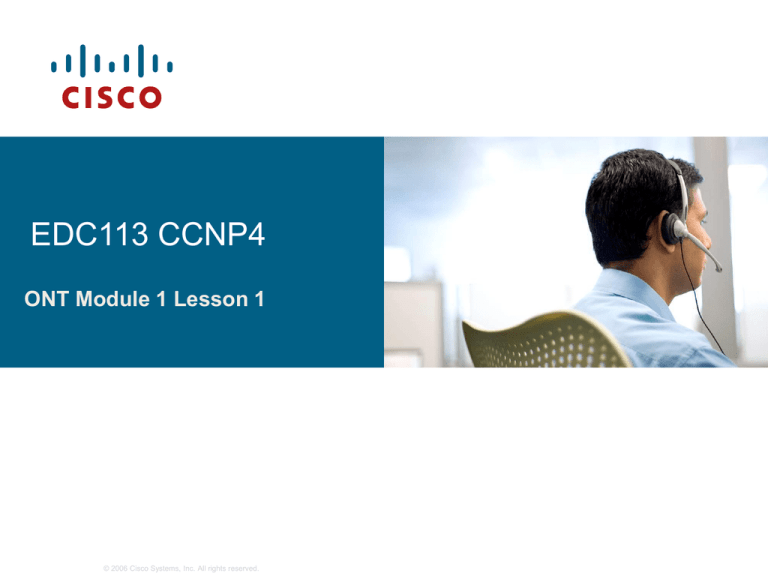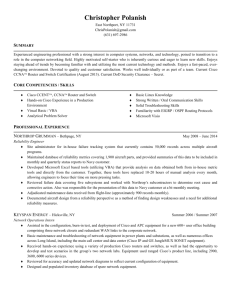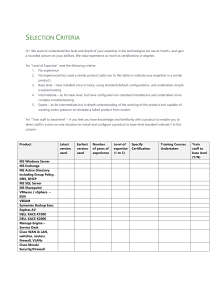
EDC113 CCNP4
ONT Module 1 Lesson 1
© 2006 Cisco Systems, Inc. All rights reserved.
http://portal.techhigh.us/Teachers/mannf/Pages/default.aspx
© 2006 Cisco Systems, Inc. All rights reserved.
Class site
Four Major Sections
Announcements
Assignments
Links
Documents
© 2006 Cisco Systems, Inc. All rights reserved.
Announcements
•Lesson Breakdowns
•Class changes and other
information
•Current tests available through
cisco.netacad.net
© 2006 Cisco Systems, Inc. All rights reserved.
Assignments
•Weekly
Assignments
Module
purpose
and scope
Reading
Homework
E-labs
© 2006 Cisco Systems, Inc. All rights reserved.
Links and Docs
•Links
Syllabus
Schedule
Homework
Presentation
Documents
Archive of
Presentations
Student Lab Manual
Additional Readings
Old Assignments
© 2006 Cisco Systems, Inc. All rights reserved.
Optimizing Converged
Cisco Networks (ONT)
Lesson 1.1: The Evolution of Telephony in the Enterprise
© 2006 Cisco Systems, Inc. All rights reserved.
Objectives
Describe the history of the telephone services industry
and its affect on modern business practices.
Identify the components of the traditional telephone
system.
Describe traditional POTS service.
Describe ISDN & T1 services.
Explain the drivers of converged networks.
© 2006 Cisco Systems, Inc. All rights reserved.
Basic Telephone System
A telephone system has four elements:
A telephone set to convert sound to electrical signals and back to
sound
One or more central switching facilities
Connections to the central switching facilities
Connections among multiple switching centers across telephone
networks
Subscribers connect to the telephone network using:
Dedicated wire connections in overhead or underground cables
Radio waves (cellular, satellite, or radiotelephone)
VoIP
© 2006 Cisco Systems, Inc. All rights reserved.
Basic Components of a Modern Telephone
System
Long Distance and
International Connections
IP
Central Office
with Switches
Fiber
Local
Loop
POTS and
ADSL
Home Office with
Corporate VPN
including VoIP
© 2006 Cisco Systems, Inc. All rights reserved.
Cellular Phone
System
Traditional POTS Services
PSTN or PTT (POTS) has remained practically
unchanged for over 100 years offering:
Bi-directional, or full duplex, voice path to carry sound both
ways at once
Dial tone and ringing signals
Subscriber dialing
Operator services, such as directory assistance, long distance,
and conference calling assistance
Power
© 2006 Cisco Systems, Inc. All rights reserved.
ISDN and T1 Services
ISDN: A set of standards that allow data and voice to be
carried on copper wire from the telephone exchange to
customer premises:
BRI: 2 B-channels and 1 D-channel for control
PRI: 23 B-channels (30 in Europe) and 1 D-channel for control
T1 Carrier System: Specification for digital transmission
between telephone exchanges and sometimes directly
to customer premises. T1 uses copper wire or fiber.
© 2006 Cisco Systems, Inc. All rights reserved.
Digital Telephone Services
Digital Telephone Services include:
Voice mail
Caller ID
Call waiting
Reminder calls
(Three-way) conference calling
Enhanced 911 (in North America)
Centrex
A number of other similar services
© 2006 Cisco Systems, Inc. All rights reserved.
PBX and Centrex
Centrex (a virtual PBX):
Call Transfer
Call Divert – on no reply and on busy calls
Call Waiting
Three-Party Conference
Call Pick Up (Group)
Ring Back
Reminder or Alarm Call
Typical Centrex telephone. Note the
Recall button and the Message
Last Number Redial
Waiting lamp.
Centrex Hotline (non-dialed connection)
Centrex Warm Line (delayed Hotline)
Centrex Hunt Groups, with optional bypass numbers
© 2006 Cisco Systems, Inc. All rights reserved.
Long-Distance Calling Challenges
May I have a line
to Chicago?
Is this a
business call?
PSTN
Yes it is.
Thank you. One
second please.
Chicago Office
PBX
© 2006 Cisco Systems, Inc. All rights reserved.
Long-Distance and WATS
Long-distance trunk lines connect telephone
exchanges.
Long-distance services include:
OUT-WATS: Flat-rate long-distance calling
IN-WATS: Toll-free calling using 1-8xx numbers
© 2006 Cisco Systems, Inc. All rights reserved.
Separate Voice, Video, and Data Networks
London
Office
San Jose
Office
PBX
PBX
Tokyo
Office
PBX
© 2006 Cisco Systems, Inc. All rights reserved.
Converged Voice, Video, and Data Network
PSTN
IP WAN
© 2006 Cisco Systems, Inc. All rights reserved.
Self Check
1. What are the 2 levels of ISDN service?
2. What is a Centrex?
3. What is a WATS-type plan?
4. What options are available in WATS plans?
© 2006 Cisco Systems, Inc. All rights reserved.
Summary
Companies have used telephone services for over 100
years as a part of their business practices.
Changing technology and changing enterprise needs
have influenced changes in telephony services.
The increasing use of IP transport for data, voice and
video has lead to the need for converged networks.
© 2006 Cisco Systems, Inc. All rights reserved.
Resources
Wikipedia Telephone Exchange article
http://en.wikipedia.org/wiki/Telephone_exchange
Cisco IP Telephones on Converged Network Enable
Rapid Emergency Response
http://newsroom.cisco.com/dlls/partners/success_stories/2001/p
ss_10-10.html
Making the Business Case for Unified Communications
http://www.cisco.com/en/US/netsol/ns340/ns394/ns165/networki
ng_solutions_audience_business_benefit0900aecd80472efb.ht
ml
© 2006 Cisco Systems, Inc. All rights reserved.
Module 1:
Converged Network
Connectivity
Requirements
Lesson 1.2: Describing Converged Network Requirements
© 2006 Cisco Systems, Inc. All rights reserved.
Objectives
Explain the Cisco conceptual network models, such as
Cisco Enterprise Architecture and Cisco hierarchical
network model.
Describe the traffic conditions in a converged network.
Describe the IIN and the SONA framework.
© 2006 Cisco Systems, Inc. All rights reserved.
Traditional Hierarchical Model
© 2006 Cisco Systems, Inc. All rights reserved.
Cisco Enterprise Architecture
© 2006 Cisco Systems, Inc. All rights reserved.
Campus Architecture
Campus Architecture combines a core infrastructure
of intelligent switching and routing including:
IP Communications
mobility
advanced security
© 2006 Cisco Systems, Inc. All rights reserved.
Data Center Architecture
The Data Center is a cohesive, adaptive network
architecture supporting:
requirements for consolidation
business continuance
security
© 2006 Cisco Systems, Inc. All rights reserved.
Branch Architecture
The Branch allows enterprises to extend head-office
applications and services including:
security
IP communications
advanced application performance supporting
thousands of remote locations/users
© 2006 Cisco Systems, Inc. All rights reserved.
Teleworker Architecture
Teleworker architecture allows enterprises to securely
deliver voice and data services to remote, small or
home offices.
© 2006 Cisco Systems, Inc. All rights reserved.
WAN Architecture
WAN architecture offers the convergence of voice,
video and data services over a single IP
communications network.
© 2006 Cisco Systems, Inc. All rights reserved.
Example: Enterprise Network
© 2006 Cisco Systems, Inc. All rights reserved.
Network Traffic Mix and Requirements
Converged network traffic mix:
Voice and video traffic
Voice applications traffic
Mission-critical applications traffic
Transactional traffic
Routing update traffic
Network management traffic
Bulk transfer (best-effort) and scavenger (less-than-best-effort)
traffic
Key requirements:
Performance (bandwidth, delay, and jitter)
Security (access and transmission)
© 2006 Cisco Systems, Inc. All rights reserved.
Example: Integrated Services in a Converged
Network
© 2006 Cisco Systems, Inc. All rights reserved.
Intelligent Information Network (IIN)
IIN integrates networked resources and information
assets.
IIN extends intelligence across multiple products and
infrastructure layers.
IIN actively participates in the delivery of services and
applications.
© 2006 Cisco Systems, Inc. All rights reserved.
Phases of IIN
Three phases in building an IIN are:
Integrate transport
Integrate services
Integrate applications
© 2006 Cisco Systems, Inc. All rights reserved.
Cisco SONA Framework
Cisco SONA is an architectural framework.
Cisco SONA brings several advantages to enterprises:
Outlines how enterprises can evolve toward the IIN
Illustrates how to build integrated systems across a fully
converged intelligent network
Improves flexibility and increases efficiency
Cisco provides an extensive product line, services,
proven architectures, and experience to help the
enterprises achieve their business goals.
© 2006 Cisco Systems, Inc. All rights reserved.
Cisco SONA Layers
© 2006 Cisco Systems, Inc. All rights reserved.
SONA—Networked Infrastructure Layer
The goal is “anywhere/anytime connectivity.”
© 2006 Cisco Systems, Inc. All rights reserved.
SONA—Interactive Services Layer
Interactive services includes:
voice and collaboration
services
mobility services
security and identity services
storage services
computer services
© 2006 Cisco Systems, Inc. All rights reserved.
application networking services
network infrastructure
virtualization
services management
adaptive management services
SONA—Application Layer
Application Layer includes:
business applications
collaboration applications
© 2006 Cisco Systems, Inc. All rights reserved.
Self Check
1. What are the 3 building blocks of the hierarchical
model?
2. Describe the special needs of voice and video traffic.
3. What types of traffic could be considered best-effort
and less-than-best-effort?
4. What is AON?
5. What are the 3 layers of SONA?
© 2006 Cisco Systems, Inc. All rights reserved.
Summary
The traditional three-layer hierarchical model no longer
completely meets the needs of large converged
networks carrying voice, video, and data. IIN aligns IT
resources with business priorities.
Cisco Enterprise Architecture and SONA provide a
framework for deploying converged networks.
Dealing with complex traffic mixes is a key feature of
Cisco Enterprise Architecture. The Service layer of
SONA addresses the performance and security
requirements of converged networks.
IIN aligns IT resources with business priorities.
Cisco SONA provides an evolutionary path to IIN.
© 2006 Cisco Systems, Inc. All rights reserved.
Q and A
© 2006 Cisco Systems, Inc. All rights reserved.
Resources
Business Overview of Cisco SONA
http://cisco.com/en/US/netsol/ns340/ns394/ns431/networking_s
olutions_white_paper0900aecd803efff3.shtml
What is IIN?
http://cisco.com/en/US/netsol/ns650/networking_solutions_mark
et_segment_solution.html
Enterprise Architectures Poster
http://cisco.com/application/pdf/en/us/guest/netsol/ns477/c643/c
dccont_0900aecd802843ce.pdf
© 2006 Cisco Systems, Inc. All rights reserved.
© 2006 Cisco Systems, Inc. All rights reserved.




